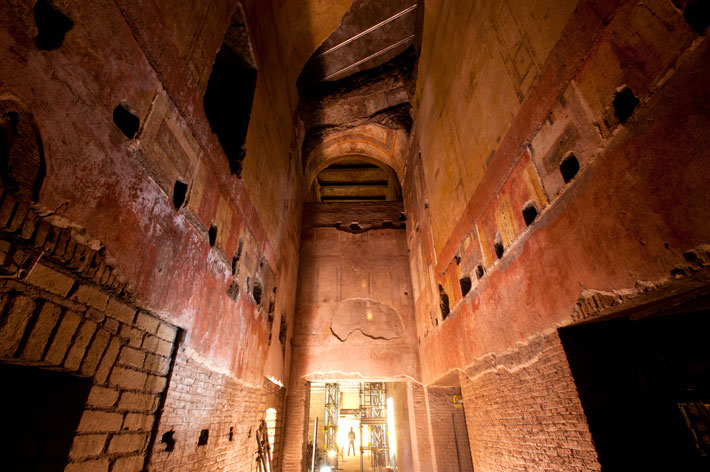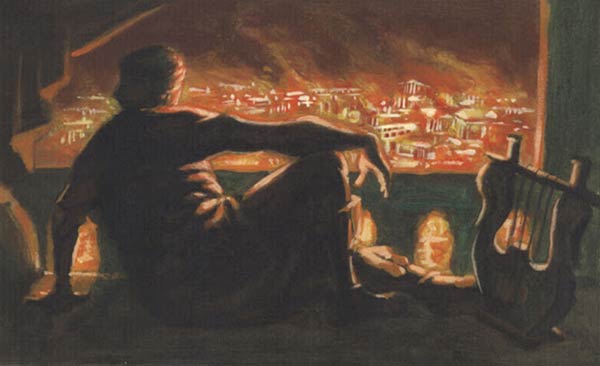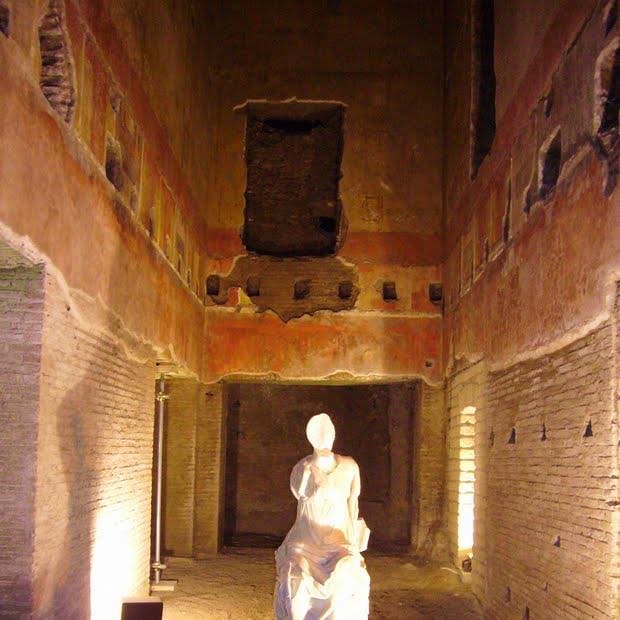
PHOTO: archaeology.org
The Roman Emperor Nero left behind a great many architectural wonders. He might have been an infamous, ridiculously cruel tyrant, but the physical legacy he left behind is one of opulence and luxury that matches the life he lived as described by Roman historians like Tacitus and Suetonius.
The crown jewel of his architectural legacy was his famous “Golden Palace”, the Domus Aurea, the ultimate bachelor pad that Nero constructed for himself on Palatine Hill, just after the Great Fire of Rome in AD 64. Today, we’ll take a closer look at this architectural wonder that’s been astounding politicians, archaeologists, artists, architects, and historians since our mad Emperor first built it.
A Reign of Imperial Infamy
![The Julio-Claudian dynasty. Left to right: Julius Caesar, Augustus Caesar, Tiberius Caesar, Gaius Caesar (Caligula), and Caesar Nero. [PHOTO: gohighbrow.com]](https://historythings.com/wp-content/uploads/2017/01/2.2-Julio-Claudian-dynasty.jpg)
The Julio-Claudian dynasty. Left to right: Julius Caesar, Augustus Caesar, Tiberius Caesar, Gaius Caesar (Caligula), and Caesar Nero. [PHOTO: gohighbrow.com]
Nero is, perhaps, one of the most infamous of all the Roman Emperors of the Julio-Claudian dynasty, a dynasty that, after the death of Caesar Augustus, was followed by four more emperors, each more insane and cruel than the last.
He took his throne by murdering his great-uncle, Claudius, and would go on to murder countless others who he thought were plotting against him. Nero was notoriously paranoid, and notoriously insane. He thought himself an artist, competed as a charioteer, tortured hundreds of thousands of people for fun, and liked to disguise himself as a female prostitute and go out in the middle of the night to have sex with other men. He married his step-sister, divorced her, and then married his mistress, who he later kicked to death in a fit of rage.

PHOTO: ancient-origins.net
When the Great Fire of Rome swept across the city in AD 64, Nero sat and watched from his palace, harp in hand, as the flames engulfed the aristocratic homes on the slopes of Palatine Hill. The mad emperor couldn’t be happier. The fire couldn’t be more convenient.
He now had the room to build his dream home… right where he wanted it.
Construction of the Domus Aurea
“In no other matter did [Nero] act more wasteful than in building a house that stretched from the Palatine to the Esquiline Hill, which he originally named “Transitoria” [House of Passages], but when soon afterwards it was destroyed by fire and rebuilt he called it “Aurea” [Golden House].”
– Suetonius, The Lives of the Caesars.
![Palatine Hill today. [PHOTO: javanesewanderer.com]](https://historythings.com/wp-content/uploads/2017/01/dsc_0896-1024x681.jpg)
Palatine Hill today. [PHOTO: javanesewanderer.com]
The palace was constructed as a massive villa which would be comprised of two floors with 300 rooms in all. The accompanying gardens were to cover 125 acres of land, and, as Suetonius describes to us, would house large lake “like a sea”, the buildings arrayed were around it at if the palace were a tiny city. There would be orchards and wheat fields and fruit and herb gardens. There were pastures to house domesticated animals, like sheep and cows, and cages and zoos to house wild animals, too. To top it all off, Nero demanded that the imperial treasury be emptied in order to fund a 120-foot-tall bronze statue of himself, depicted as the Sun God, Sol, of course!
Perhaps the most architecturally impressive part about Nero’s pleasure palace is the banquet hall, the famous “coenatio rotunda”. His banquet hall was described by the Roman historian Suetonius in his Lives of the Caesars:
“The chief banqueting room was circular, and revolved perpetually night and day in imitation of the motion of the celestial bodies.” – Suetonius.
The panels of the room would slide back and forth, showering flower petals and perfumes on Nero’s dinner guests. Nero would sit at the center of the hall, and his guests would orbit around him like planets around the sun. It sounds too extravagant to be real, but archaeologists working on Palatine Hill in 2009 confirmed the existence of this banquet hall, and it did, indeed, rotate, using a rotating mechanism that was powered by water. It measures over 50 feet in diameter, and rested on a 13-foot wide pillar.
![The center pillar of Nero's famous rotating banquet hall. [PHOTO: dailymail.co.uk]](https://historythings.com/wp-content/uploads/2017/01/article-1216986-06A20779000005DC-225_634x571.jpg)
The center pillar of Nero’s famous rotating banquet hall. [PHOTO: dailymail.co.uk]
The complex also sported a massive set of baths fed by a 50-foot-long aqueduct connected to various mineral hot springs, and there was an amphitheater to host plays and Nero’s famous night-long performances of music and poetry. Yet, Nero didn’t live there. His pleasure palace was purely for entertainment. Archaeologists have yet to find one sleeping quarters among the some-300 rooms in the building.
When the Golden Palace was finished, Nero looked over the architect’s work, took a tour of his home, and declared: “Now I can begin to live like a human being!”
The Ultimate Bachelor Pad

PHOTO: hikersbay.com
Nero’s Golden Palace would stand for four years after its construction, and he would make use of every inch of it. Archaeologist Wallace-Hadrill told an interviewer, “Nero gave the best parties ever. Three hundred years after his death, tokens bearing his head were still being given out at public spectacles – a memento of the greatest showman of them all.”
His rotating banquet hall was home to wild drinking parties, lavish displays of disgusting amounts of wealth, and massive orgies, all for Nero. He took his boyfriend to court here and treated him like a wife. He invited all his favorite aristocrats to grand parties at his pleasure palace, and used the luxury to help alleviate some of his unpopularity that he’d garnered for being a vicious sadist.
While his parties were going on, he liked to roll Christians and criminals in tar, impale them on stakes, and set them on fire as ‘mood lighting’ in his massive gardens. While the screams and the fire set the tone for the party, his guests would dine on gallons of wine, peacock, swan, stuffed sow’s wombs, and roasted dormice. In between courses, they’d mingle with all the male and female prostitutes Nero had hired for the event. If there were no Christians to burn during the party, Nero would settle for regaling everyone with his lute-strumming and recitations of poetry…and nobody could leave until he was finished.
Eventually, Nero became so paranoid and unpopular that he killed himself. That was the end of the Julio-Claudian dynasty. Rome would fall into a brief period of chaos, during which Nero’s ridiculously extravagant palace would be sacked, ransacked, and sacked again. Thieves stripped it entirely of its marble, ivory, and jewels, and Rome would not see such architectural luxury again until Emperor Vespasian took power and built the famous Great Colosseum of Rome.

